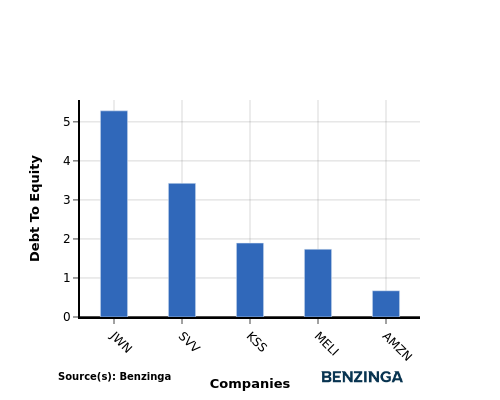In today's rapidly changing and fiercely competitive business landscape, it is essential for investors and industry enthusiasts to thoroughly analyze companies. In this article, we will conduct a comprehensive industry comparison, evaluating Amazon.com AMZN against its key competitors in the Broadline Retail industry. By examining key financial metrics, market position, and growth prospects, we aim to provide valuable insights for investors and shed light on company's performance within the industry.
Amazon.com Background
Amazon is a leading online retailer and one of the highest-grossing e-commerce aggregators, with $386 billion in net sales and approximately $578 billion in estimated physical/digital online gross merchandise volume in 2021. Retail-related revenue represents approximately 80% of the total, followed by Amazon Web Services' cloud computing, storage, database, and other offerings (10%-15%), advertising services (5%), and other. International segments constitute 25%-30% of Amazon's non-AWS sales, led by Germany, the United Kingdom, and Japan.
| Company | P/E | P/B | P/S | ROE | EBITDA (in billions) | Gross Profit (in billions) | Revenue Growth |
|---|---|---|---|---|---|---|---|
| Amazon.com Inc | 65.19 | 9.74 | 3.45 | 5.52% | $28.22 | $29.27 | 13.91% |
| Alibaba Group Holding Ltd | 13.98 | 1.30 | 1.50 | 1.41% | $37.55 | $104.13 | 5.08% |
| PDD Holdings Inc | 21.28 | 6.22 | 5.16 | 13.33% | $26.88 | $53.8 | 29.11% |
| MercadoLibre Inc | 77.47 | 24.89 | 5.31 | 5.68% | $0.45 | $1.96 | 41.94% |
| JD.com Inc | 12.83 | 1.32 | 0.29 | 1.47% | $4.23 | $43.5 | 23.57% |
| Coupang Inc | 25.41 | 8.31 | 1.41 | 29.43% | $0.26 | $1.68 | 23.16% |
| eBay Inc | 9.96 | 4.20 | 2.73 | 11.78% | $1.34 | $1.85 | 2.07% |
| Vipshop Holdings Ltd | 8.58 | 1.81 | 0.62 | 8.35% | $3.79 | $8.23 | 52.31% |
| Dillard's Inc | 9.42 | 4.03 | 1.01 | 14.27% | $0.36 | $0.81 | -0.17% |
| MINISO Group Holding Ltd | 24.77 | 5.70 | 3.91 | 7.0% | $0.86 | $1.58 | 36.74% |
| Macy's Inc | 52.45 | 1.32 | 0.23 | -1.69% | $0.16 | $3.3 | -2.42% |
| Ollie's Bargain Outlet Holdings Inc | 25.04 | 2.98 | 2.16 | 5.19% | $0.11 | $0.26 | 18.04% |
| Nordstrom Inc | 24.15 | 3.81 | 0.22 | 16.99% | $0.46 | $1.6 | 2.34% |
| Savers Value Village Inc | 51.38 | 7.50 | 1.82 | 12.73% | $0.06 | $0.22 | 4.35% |
| Kohl's Corp | 8.31 | 0.67 | 0.15 | 4.87% | $0.49 | $2.1 | -1.05% |
| D-MARKET Electronic Services & Trading | 11.88 | 4.08 | 0.69 | -5.6% | $0.79 | $2.41 | 52.02% |
| Average | 25.13 | 5.21 | 1.81 | 8.35% | $5.19 | $15.16 | 19.14% |
Upon a comprehensive analysis of Amazon.com, the following trends can be discerned:
-
At 65.19, the stock's Price to Earnings ratio significantly exceeds the industry average by 2.59x, suggesting a premium valuation relative to industry peers.
-
The elevated Price to Book ratio of 9.74 relative to the industry average by 1.87x suggests company might be overvalued based on its book value.
-
The Price to Sales ratio of 3.45, which is 1.91x the industry average, suggests the stock could potentially be overvalued in relation to its sales performance compared to its peers.
-
The company has a lower Return on Equity (ROE) of 5.52%, which is 2.83% below the industry average. This indicates potential inefficiency in utilizing equity to generate profits, which could be attributed to various factors.
-
Compared to its industry, the company has higher Earnings Before Interest, Taxes, Depreciation, and Amortization (EBITDA) of $28.22 Billion, which is 5.44x above the industry average, indicating stronger profitability and robust cash flow generation.
-
With higher gross profit of $29.27 Billion, which indicates 1.93x above the industry average, the company demonstrates stronger profitability and higher earnings from its core operations.
-
The company is witnessing a substantial decline in revenue growth, with a rate of 13.91% compared to the industry average of 19.14%, which indicates a challenging sales environment.
Debt To Equity Ratio

The debt-to-equity (D/E) ratio helps evaluate the capital structure and financial leverage of a company.
Considering the debt-to-equity ratio in industry comparisons allows for a concise evaluation of a company's financial health and risk profile, aiding in informed decision-making.
When evaluating Amazon.com alongside its top 4 peers in terms of the Debt-to-Equity ratio, the following insights arise:
-
Compared to its top 4 peers, Amazon.com has a stronger financial position indicated by its lower debt-to-equity ratio of 0.67.
-
This suggests that the company relies less on debt financing and has a more favorable balance between debt and equity, which can be seen as a positive attribute by investors.
Key Takeaways
For Amazon.com, the PE, PB, and PS ratios are all high compared to its peers in the Broadline Retail industry, indicating that the stock may be overvalued. The low ROE suggests that Amazon.com is not generating significant returns on shareholder equity. However, the high EBITDA and gross profit figures reflect strong operational performance. The low revenue growth rate may be a concern for Amazon.com compared to its industry peers.
This article was generated by Benzinga's automated content engine and reviewed by an editor.
Edge Rankings
Price Trend
© 2025 Benzinga.com. Benzinga does not provide investment advice. All rights reserved.
Trade confidently with insights and alerts from analyst ratings, free reports and breaking news that affects the stocks you care about.